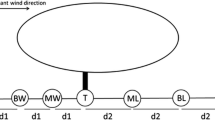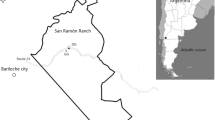Abstract
The composition of the germinable seed bank was studied in four vegetation states of the Festuca pallescens grasslands in semiarid Patagonia during four years. The aim of this study was to test whether aboveground vegetation states resulting from grazing exclusion or different combinations of grazing and topography are reflected in different states of the germinable seed bank. The size of the total and dicot germinable seed bank was positively related to the total cover in each state. Dicots dominated all germinable seed bank states. Carex patagonica increased its cover as well as its germinable seed bank under grazing disturbance. Grazing did not reduce the germinable seed bank of perennial grasses in uplands where the grazing pressure is lower as compared with slopes. In slopes the germinable seed bank of perennial grasses was significantly reduced by grazing. A reduction of the length of the grazing period in late spring increases the germinable seed bank of perennial grasses both in upland and slope. These results are interpreted in the frame of a model of management techniques where grazing exclusion during late spring and late summer increases the seed bank of the perennial grasses and promotes their establishment in uplands. The artificial addition of seeds of perennial grasses and the manipulation of the soil surface in order to increase “safe sites” appear as management alternatives that deserve further evaluation to improve plant reestablishment in slopes.
Similar content being viewed by others
Literature Cited
Archer, S., and L. L. Tieszen. 1986. Plant response to defoliation: Heirarchical considerations. Pages 45-59, in Grazing research at northern latitudes. Nato ASI Series A: Life Science, Vol. 108. Plenum Press, London.
Ares, J. O., A. M. Beeskow, M. B. Bertiller, C. M. Rostagno, M. P. Irisarri, J. Anachorena, G. E. Defossé, and C. A. Merino. 1990. Structural and dynamic characteristics of overgrazed grasslands of northern Patagonia. Pages 149-175, in A. Breymeyer (ed.), Managed grasslands. Regional studies. Elsevier, Amsterdam.
Beeskow, A. M., H. F. del Valle, and C. M. Rostagno. 1987. Los sistemas fisiográficos de la región árida y semiárida de la Provincia del Chubut, Argentina. S.C. de Bariloche, Río Negor: SECYT Delegación Regional Patagónica.
Belsky, A. J. 1986. Does herbivory benefit plants? A review of the evidence. American Naturalist 127:870–892.
Bertiller, M. B. 1992. The seed bank of a Patagonian grassland in relation to grazing, topography. Journal of Vegetation Science 3:47–54.
Bertiller, M. B. 1995. Modelos ecológicos alternativos de la dinámica de la vegetación en ecosistemas de pastizales: un caso de estudio en la Patagonia. Revista Argentina de Productión Animal 14(in press).
Bertiller, M. B., and F. R. Coronato. 1994. Seed bank patterns of Festuca pallescens in semiarid Patagonia (Argentina): a possible limit to bunch reestablishment. Biodiversity and Conservation 3:57–67.
Bertiller, M. B., N. Elissalde, C. M. Rostagno and G. E. Defossé. 1995. Environmental patterns and plant species distribution along a gradient of precipitation in western Patagonia. Journal of Arid Environments 29:85–97.
Chambers, J. C. 1992. Seed and vegetation dynamics in an alpine herb field: effects of disturbance type. Canadian Journal of Botany 71:471–485.
Coffin, D. P., and W. K. Lauenroth, 1989. Spatial and temporal variation in the seed bank of a semiarid grassland. American Journal of Botany 76:53–58.
Correa, M. N. 1969, 1971, 1978, 1984, 1988. Flora patagónica, Partes II, VII, III, IV a, b, V. Colección Científica Tomo VIII. Instituto Nacional de Tecnología Agropecuaria (INTA), Buenos Aires.
Defossé, G. E., M. B. Bertiller, and J. O. Ares. 1990. Aboveground phvtomass dynamics in a grassland steppe of Patagonia, Argentina. Journal of Range Management 43:157–160.
Eriksson, O., and J. Ehrlén. 1992. Seed and microsite limitation of the recruitment in plant population. Oecologia 91:360–364.
Fahrig, L. 1990. Interacting effects of disturbance and dispersal on individual selection and population stability. Comments on Theoretical Biology 1:275–297.
Fowler, N. L. 1988. What is a safe site?: neighbor, litter, germination date, and patch effects. Ecology 69:947–961.
George, M., J. Brown, and W. J. Clawson, 1992. Application of nonequilibrium ecology to management of Mediterranean grasslands. Journal of Range Management 45:436–440.
Gilfedder, L., and J. B. Kirkpatrick, 1993. Germinable soil seed bank and competitive relationships between a rare native species and exotics in a semi-natural pasture in the midlands, Tasmania. Biological Conservation 64:113–119.
Grime, J. P. 1989. Seed Banks in the ecological perspective. Pages XV-XXII, in M. A. Leck, V. T. Parker, and R. L. Simpson (eds.), Ecology of soil seed banks. Academic Press, San Diego, California.
Harper, J. L. 1977. Population biology of plants. Academic Press, London.
Hickman, J. C. 1975. Environmental unpredictability and plastic energy allocation strategies in the annual Polygonum cascadense (Polygonaceae). Journal of Ecology 63:689–701.
Keddy, P. A. 1990. The use of functional as opposed to phylogenetic systematics: a first step in predictive community ecology. Pages 387-406, in S. Kawano (ed.), Biological approaches and evolutionary trends in plants. Academic Press. London.
Keddy, P. A., I. C. Wisheu, B. Shipley, and C. Gaudet. 1989. Seed bank and vegetation management for conservation: Toward predictive community ecology. Pages 347-363, in M. A. Leck, V. T. Parker, and R. L. Simpson (eds.), Ecology of soil seed banks. Academic Press, San Diego, California.
Kemp, P. R. 1989. Seed banks and vegetation processes in deserts. Pages 257-281, in M. A. Leck, V. T. Parker, and R. L. Simpson (eds.), Ecology of soil seed banks. Academic Press, San Diego, California.
Kinucan, R. J. and F. E. Smeins. 1992. Soil seed bank of a semiarid Texas grassland under three long-term (36-years) grazing regimes. The American Midland Naturalist 128:11–21.
León, R. J. C., and M. R. Aguiar. 1985. El deterioro por uso pasturil en estepas herbáceas patagónicas. Phytocoenologia 13:181–196.
Louda, S. M. 1989. Predation in the dynamics of seed regeneration. Pages 25-51, in M. A. Leck, V. T. Parker, and R. L. Simpson (eds.), Ecology of soil seed banks. Academic Press, San Diego, California.
Matlack, G. R., and R. E. Good. 1990. Spatial heterogeneity in the soil seed bank of mature Coastal Plain forest. Bulletin of the Torrey Botanical Club. 117:143–152.
Milberg, P. 1992. Seed bank in a 35-year-old experiment with different treatments of a semi-natural grassland. Acta Oecologica 13:743–752.
Mueller-Dombois, D., and H. Ellemberg. 1974. Aims and methods of vegetation ecology. John Wilev and Sons, New York.
Norusis, M. J. 1986. SPSS/PC + for the IBM PC/XT/AT. SPSS inc., Chicago.
O’Connor, T. G., and G. A. Pickett. 1992. The influence of grazing on seed production and seed banks of some African savanna grasslands. Journal of Applied Ecology 29:247–260.
Parker, V. T., R. L. Simpson, and M. A. Leck. 1989. Patterns in the dynamics of seed banks. Pages 367-384. in M. A. Leck, V. T. Parker, and R. L. Simpson (eds.), Ecology of soil seed banks. Academic Press, San Diego, California.
Rabinowitz, D., and J. K. Rapp. 1981. Dispersal abilities of seven sparse and common grasses from a Missouri prairie. American Journal of Botany 68:616–624.
Rabotnov, T. A. 1956. Some data on the content of living seeds in soils of meadow communities. Pages 481-499, in Akademika V. N. Sukacheva k 75-letiyo so duia rozhdeniia. Akademiya Nauk SSSR, Moscow.
Raynall, D. L. 1979. Population ecology of Hieracium florentinum (Compositae) in a central New York limestone quarry. Journal of Applied Ecology. 16:287–298.
Reichman, O. J., J. H. Benedix, and T. R. Seastedt. 1993. Distinct animal-generated edge effects in a tallgrass prairie community. Ecology 74:1281–1285.
Rice, K. J. 1989. Impacts of seed banks on grassland community structure and population dynamics. Pages 211-230. in M. A. Leck, V. T. Parker, and R. L. Simpson (eds.), Ecology of soil seed banks. Academic Press, San Diego, California.
Roberts, H. A. 1986. Seed persistence in soil and seasonal emergence in plant species from different habitats, journal of Applied Ecology 23:639–656.
Roos, R. H., and J. A. Quinn. 1977. Phenology and reproductive allocation in Andropogon scoparius (Gramineae) populations in communities of different successional stages. American Journal of Botany 64:535–540.
Russi, L, P. S. Cocks, and E. H. Roberts. 1992. Seed bank dynamics in a Mediterranean grassland. Journal of Applied Ecology 29:763–771.
Salonen, V., and H. Setala. 1992. Plant colonization of bare peat surface-relative importance of seed availability and soil. Ecography 15:199–204.
Schupp, E. W. 1988. Seed and early seedling predation in the forest understory and treefall gaps. Oikos 51:71–78.
Thompson, K. 1986. Small-scale heterogeneity in the seed bank of an acidic grassland. Journal of Ecology 74:733–738.
Thompson, K., and J. P. Grime. 1979. Seasonal variation in the seed banks of herbaceous species in ten contrasting habitats. Journal of Ecology 67:893–921.
van der Valk, A. G., and R. L. Pederson. 1989. Seed banks and the management and restoration of natural vegetation. Pages 329–346 in M. A. Leck, V. T. Parker, and R. L. Simpson (eds.), Ecology of soil seed banks. Academic Press, San Diego, California.
van Tooren, B. F. 1988. The fate of seeds after dispersal in chalk grassland: the role of the bryophyte layer. Oikos 53:41–48.
Verkaar, H. J. 1988. Are defoliators beneficial for their host plants in terrestrial ecosystems-a review. Acta Botanica Neerlandica 37:137–152.
Willson, M. F. and C. J. Whelan. Variation in escape from predation of vertebrate-dispersed seeds: effects of density, habitat, location, season, and species. Oikos 57:191–198.
Author information
Authors and Affiliations
Rights and permissions
About this article
Cite this article
Bertiller, M.B. Grazing effects on sustainable semiarid rangeiands in Patagonia: The state and dynamics of the soil seed bank. Environmental Management 20, 123–132 (1996). https://doi.org/10.1007/PL00006692
Issue Date:
DOI: https://doi.org/10.1007/PL00006692




